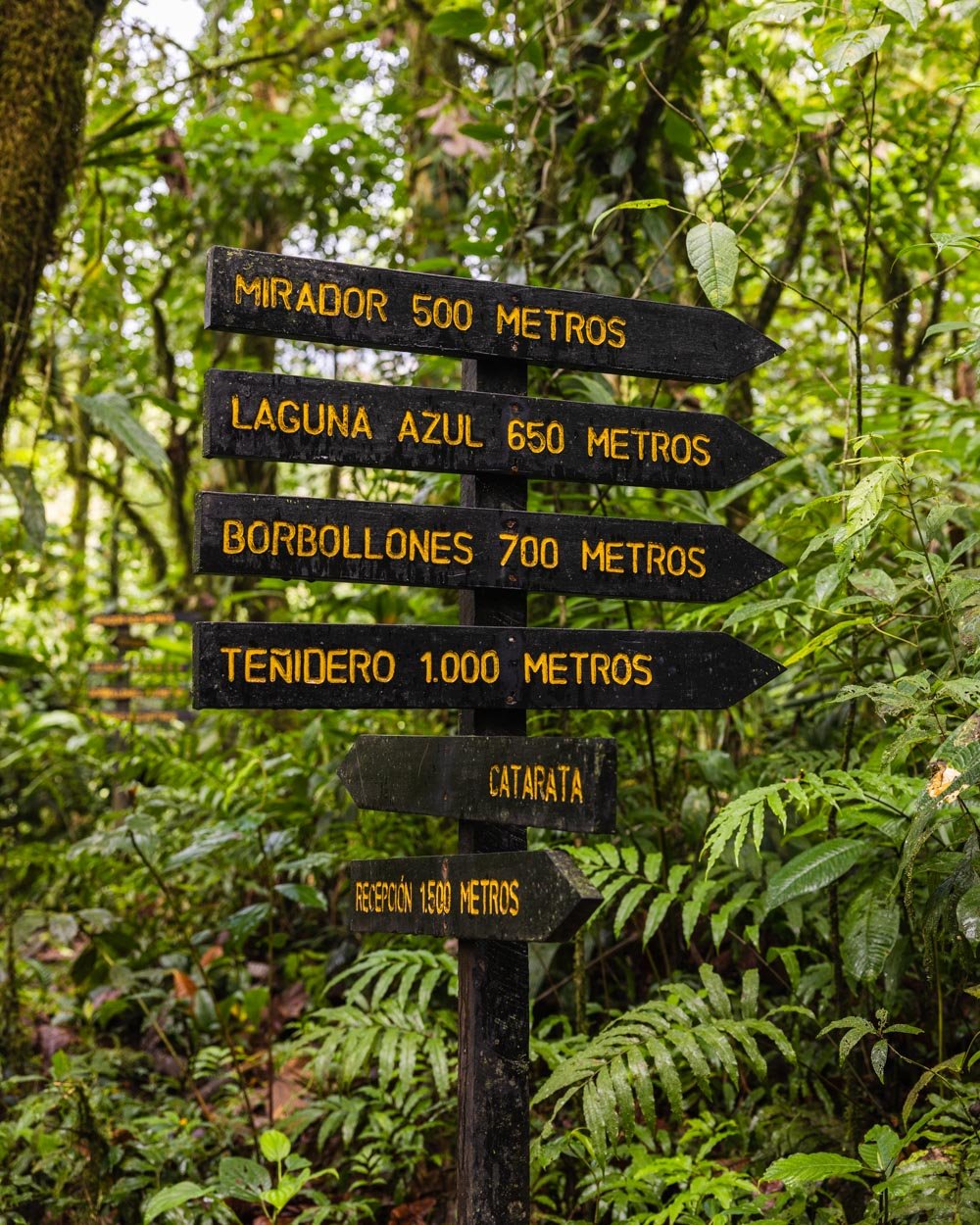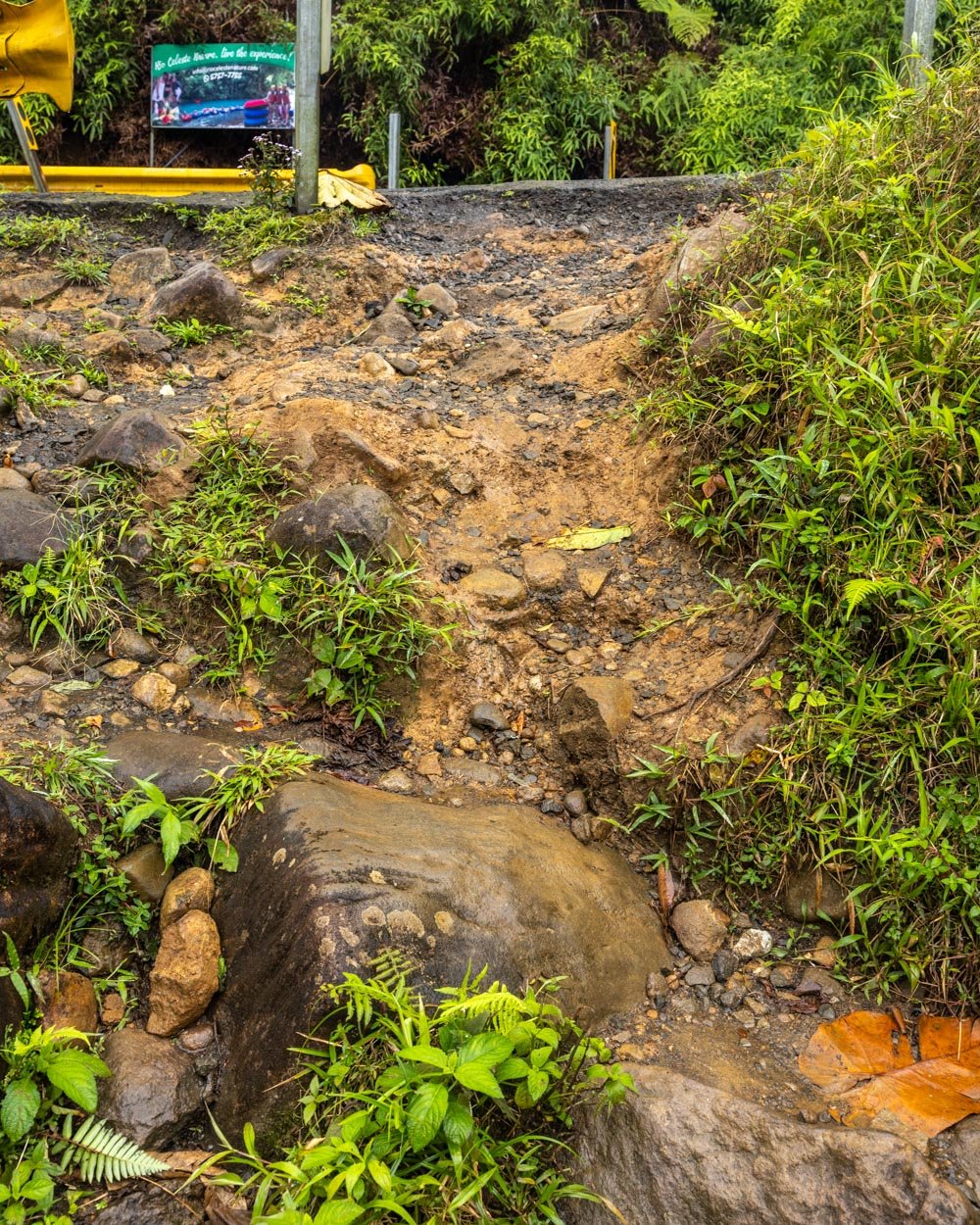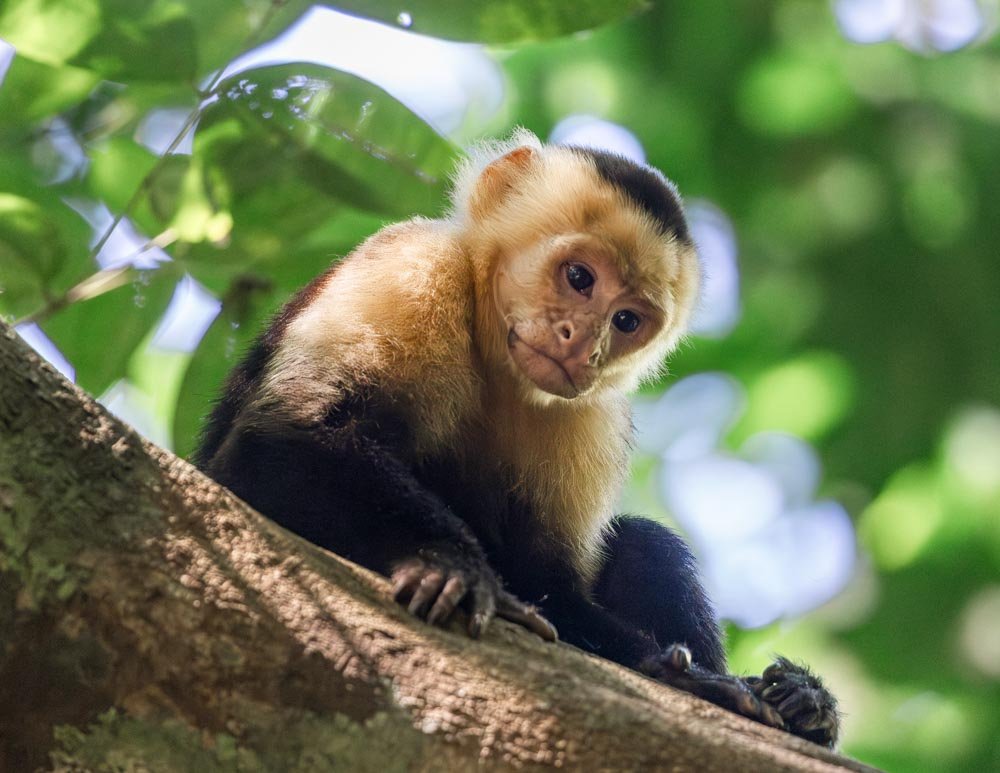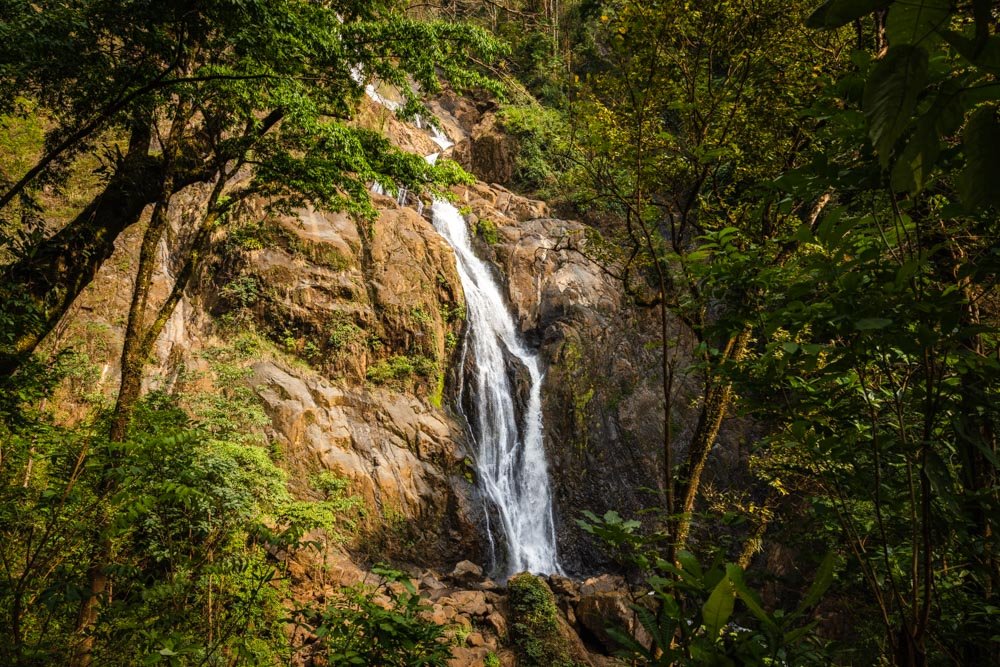Rio Celeste Waterfall is one of the most beautiful I have ever seen. Having first visited in 2008, before it became a major tourist attraction, I wondered if it might not be as special second time around. It turns out that somewhere this spectacular is just as good second time round, famous or not!
However, if you want to experience Rio Celeste as its absolute best, then you probably want to avoid the crowds, which is where we come in. We’re sharing how we got it to ourselves for over an hour in peak season - and we didn’t go at opening time!
The only thing that may disappoint you about a visit to Rio Celeste waterfall, even if you get your timing right, is the fact you can no longer swim here. However, there are several amazing swimming spots nearby that are part of the same river system, so whilst you can’t swim at the base of the falls, you can swim in that incredible turquoise water.
Here’s everything you need to know to plan the perfect trip to Rio Celeste.
Rio Celeste Waterfall
In this guide we’re going to start with how to avoid the crowds, followed by a detailed breakdown of the trail itself. When it comes to the trail, you can either choose simply to walk to the waterfall, or to continue on to several more beautiful spots before returning the same way. We recommend the latter, not just because it’s a lovely walk with more to see, but it also helps you avoid the crowds at the waterfall itself, more on that below.
How to avoid the crowds
Rio Celeste is the most famous waterfall in Costa Rica, and people come from as far away as La Fortuna, Liberia and San Jose to visit (the closest of these is a 3 hour round trip).
It’s not surprising it shot to fame as the water colour really is out of this world. So when we talk about avoiding the crowds, we really do mean crowds!
1. Avoid weekends
We’re going to start with the obvious, but every single place we visited on our seven week trip to Costa Rica was more busy on weekends.
As well as many tourists, Costa Ricans are also happy to travel pretty far on weekends, so you get a double whammy crowds-wise. If you really can’t avoid a weekend, then our hack will likely still work, but if you can go midweek, it’s going to be better odds.
2. Don’t go early
Our gut instinct when it comes to spots that are this popular is to go for sunrise. However, Tenorio National Park - where Rio Celeste Waterfall is located - doesn’t even open until 8am. 8am is no deterrent for anyone, especially in Costa Rica, where people generally start their days pretty early.
Most people will tell you to come for 8am, but honestly if you want to experience the falls alone, the only way this would work is if you hotfoot it straight to the waterfall and then enjoy your 5-10 minutes before everyone arrives just behind you. That’s what we did at La Fortuna Waterfall and it wasn’t the best experience.
The thing that is in your favour with Rio Celeste is that all sources (including the government website for the national park) itself will tell you that the park closes at 4pm.
Happily this is not the case! I asked the person I bought the entry ticket from whether 4pm was a strict close time, assuming she would say yes. In fact her answer was: somewhere between 4pm and 5pm is ok! I was pretty elated at this point because I knew that almost everyone would have read the same as me, that close time was strictly at 4pm.
There is however a cut off time for entering the park, so that’s where planning your walk will also come into play.
3. Do the full walk or come with patience
Technically speaking, the last entry to the national park is at 2pm. Judging by the fact we came in around this time and there were heaps of people behind us, we doubt this is strictly imposed - but don’t test this one as if you do miss entering then you’ve probably wasted your day. So aim to be in before 2pm.
The waterfall is just 1.6km from the start of the trail. Even stopping to see every bird along the way, it’s too short for you to go straight to the waterfall and expect it to be quiet. Your best bet is to continue along the whole trail, which goes for another 1km after the falls. There are lots of nice little places to stop and relax at, which we’ll go into details on below.
Take your time and then visit Rio Celeste on the way back. We arrived at the waterfall a little before 4pm - the time everyone thought they had to have exited the park by. And absolutely everybody had! We couldn’t believe it. We’d seen well over a hundred people here earlier, yet we had the waterfall to ourselves for an entire hour. At which point we quickly walked back and exited just a little after 5pm.
If you’re not going to do the full walk - at a leisurely pace - you’ll have to be patient as you will have quite a wait on your hands. But the longer walk is lovely, so it’s well worth doing.
4. The caveat
The thing you do need to watch out for with our approach is the weather and light. We were lucky with the day brightening up as it went along so by the time we came back to the waterfall at 4pm the light was pretty much as good as it had been at 2.30pm.
However, if you are keen on photography you might want to pop to the waterfall twice. Once on the way when it will be busy, and once on the way back when it won’t. That way you can ensure that you have some pictures where the light is brighter. That’s what we did and it worked well.
It also meant that when we returned we got a few pics on the staircase which we wouldn’t have been able to take earlier in the day, but then just sat and enjoyed the beauty of the falls in total peace and serenity. It was perfect.
How to make sure the water is blue
One thing to watch out for when planning your trip to Rio Celeste is that the water colour can change. If there has been heavy rain the water can lose its vibrant blue hue, and on the worst days even turn brown. This won’t happen in a bit of light rain, but we were told around six hours heavy rain can turn it.
The difficulty is that the weather forecasts in this area are notoriously unreliable. We actually visited on a day where it was forecast to be wet and grey and we had a mix of light cloud and sunshine! If you are staying in the area (which we recommend to make the most of the glorious swimming ops) then you can ask your accommodation and they can tell you what the current water conditions are like. The water can return to blue quickly, so staying an extra night can be helpful in this regard too.
You can also see the water colour before buying the entry ticket by looking down into the river at the bridge marked on Google Maps as “Rio Celeste Free Pool'“, 1.2km from the car park for Rio Celeste Waterfall (click here to find the spot).
However, if you’re going to day trip from La Fortuna or somewhere else, then you can try social media and Google reviews. Before we decided to stay in the area, this is what I did, and if you’re visiting in peak season you tend to have quite a lot to go on. Make sure you filter Instagram results by latest and same for Google reviews - filter by newest first.
I saw it was brown for a day before it returned to blue again, although it took another couple of days for it to return to its full blue colour. With Instagram, as so many people post photos and videos after their visit, it’s best to ask someone if it was that day, or it won’t be an accurate read. I tend to find on Google enough people had written something like, ‘visited today’ so you could trust it more.
The walk to Rio Celeste
The stats
Distance: 3.2km to the waterfall (1.6km each way), 5.7km for the whole trail (2.8km each way)
Elevation gain: 225m
Difficulty: Easy but not flat
The walk to Rio Celeste Waterfall is all on a well maintained track. Almost all of it is gravelled or concrete. The only significant climb is down to the waterfall and back up again, which is on stairs that are in good condition, and there are rails.
The path becomes more rustic beyond the waterfall, with some sections that are rocky and tree rooty. There is a little more climbing to do in this section, but not as much as there is to reach the waterfall. This part of the track does have a few bits which could become muddy in the rainy season, or after heavy rain. For us visiting in February it wasn’t bad at all.
Starting the trail
The walk begins on a concrete path through the forest. I have to admit I was a little disappointed because the old trail was a lot more natural and fun (and on the other side of the river surprisingly!).
However, it does get prettier and a bit more natural the further you go. It’s mainly flat, but there are a few gentle ups and downs.
After 330m the concrete gives way to gravel, and after just under 1km you’ll come to a small stream crossing.
This is easy to cross as there are lots of rocks to use as stepping stones - I guess there’s the potential that they could be under water after a lot of rain, but it’s only really a few steps.
From here you have a short steep ascent, but it only takes a few minutes before the gradient slackens, although you’ll continue uphill for several hundred metres more.
Through the forest to Rio Celeste
The forest is gorgeous throughout the walk and though it doesn’t have quite the same dense jungle vibes as some trails we’ve done in Costa Rica, it’s still very pretty. Just 100m after the path flattens you’ll reach the junction between the waterfall and the rest of the trail.
The signpost says it’s 150m to the bottom of the falls, although our watch measured it at 200m. It’s 200m of fairly steep downhill, but it’s all on concrete stairs, so the terrain is easy.
You’ll then arrive close to the bottom of the falls, but there’s a big fence to stop you getting to the pool and surrounding rocks.
Rio Celeste Waterfall
Rio Celeste Waterfall is enchanting. The turquoise water, tall cliffs and lush foliage all make for one of the most magical spots in the whole country. Even if there was no waterfall, the river itself surrounded by rainforest is a dream. It’s one of those spots where you can really lose yourself for a while.
The downside is that there is no seating whatsoever, so if you want to linger you’ll have to make peace with sitting on the damp steps - but it’s not really a hardship with that view!
The blue water looks amazing in any weather and we’ve even seen it on a really wet day, and the vibrancy of the blue was still there. In short, unless you get seriously unlucky and the water is brown, this is likely going to be one of the most spectacular waterfalls you’ve ever laid eyes on.
Continuing the trail
You can continue the trail for a further 1km past the junction at the stairs down to the waterfall. From here it gets more rustic, but isn’t too difficult. The first 150m uphill are a little steep, but then it flattens again before some more gentle uphill sections.
Your first point of interest, besides just being in the stunning rainforest, is the mirador (600m from the junction). Now I’m not going to lie, this is the least interesting of the sights along the way. You get a bit of a distant mountain view, but the better view is actually as you descend the staircase beside it!
After a steepish descent you’ll arrive at Lago Azul 200m later. The blue lake. This is a totally different shade of blue to the blue of Rio Celeste Waterfall. It’s like sapphire and utterly beautiful.
Again there’s no swimming, but it’s a lovely spot to sit beside.
The track then continues for a further 100m and you’ll start to pick up some sulfurous smells. If you’ve ever been to Rotorua, you’ll know it well. The source of the smell is the hot spring, alas not one you can go into, but it’s very pretty. You’ll see it bubbling away and it’s yet another wonderful shade of blue.
Continuing on from the hot spring, the walk is easy and flat until the end. After 100m you’ll come to a wooden bridge over the river and the water colour has changed yet again.
Just beyond this is a much more picturesque bridge and this time it’s over the same water colour as at Lago Azul. It’s slightly mind boggling how many shades of exquisite water can be found in one small area!
After crossing the bridge you’ll arrive a few minutes later at the end of the trail. This is the Tenidero, the point at which the two rivers meet. You can actually see the brown river run into the turquoise Rio Celeste and it’s a pretty amazing sight. It’s also a very serene spot and there’s a log where you can sit, relax and take it all in.
From here you retrace your steps back the way you came. Although there are a few uphill sections, there are less than there were on the way.
Additional information about Rio Celeste
Opening hours and entry fee
At time of writing the waterfall is technically open between 8am - 4pm, with the last entry being 2pm. However, as mentioned, this is loose!
The entry fee is USD $12 for non residents and 800 colones for residents (approx USD $1.40).
You can only pay by credit card, not cash here.
You don’t need a guide and the only benefit to a guide is to point out more wildlife. The trail is well marked and you can’t go wrong.
Parking for Rio Celeste
There is a car park located by the ticket office and it’s pretty huge. The parking fee is 2000 colones (approx USD $3.60) and you must display the ticket in your car. Someone will watch you drive in and come and collect the fee.
We did notice that just before the main car park someone was trying to flag us down to park in their car park. It’s only seconds away and I don’t know the price, but unless the main car park is full, there’s no need to park there.
Facilities at Rio Celeste
There are toilets before you enter the trail, as well as cafes and stands selling fruit. At time of writing there are no toilets along the trail. There was also a stall renting boots - I guess for when it’s muddy, as well as a stall offering tubing tours.
Getting to Rio Celeste Waterfall
Rio Celeste Waterfall is located in Tenorio National Park, make sure you put Rio Celeste y los Tenideros into Google Maps, not Rio Celeste as it’s also the name of a town in a different direction to the falls.
From La Fortuna the journey can be as quick as 1 hour 10, but often it’s more like 1 hour 30. From Liberia it’s about 1 hour 30. It’s around 3 hours 30 from San Jose. You do not need a 4WD, although as always in Costa Rica, expect potholes and some gravel sections.
Where to swim at Rio Celeste
As mentioned you can sadly no longer swim at the waterfall itself, but it’s a little less disappointing when you realise you can still swim in that same turquoise river.
We visited three spots, but had intended to see four if the weather had been in our favour.
The free Rio Celeste swimming spot
The free Rio Celeste swimming spot is located just under the bridge, find it by clicking here. Sure it might not fulfill all your romantic notions of tropical blue water swimming, but if you can look past the fact it’s under a bridge and beside the road, it’s pretty fantastic. The water colour is breathtaking and there’s a small section of river with low current, which makes it ideal for a dip.
Access is also easy. From the parking area (a lay-by) it takes less than two minutes to walk to the water’s edge. It’s a bit rocky, but actually not too bad, even in the rain as it was for us. You can then walk straight into the water. There are a few rocks in the water to negotiate, but it’s pretty easy.
Unfortunately though it doesn’t really show in the photos, it was absolutely pouring when we arrived, so I got to the water’s edge before bottling on a swim. Hopefully I’ll be back one day!
Just from having a look I think it would be deep once you’re away from the big rocks at the side, but I can’t say for sure.
The free-ish Rio Celeste swimming spot
This spot is a bit of a find and currently still a hidden gem, but I can’t imagine it will be forever. To clear up free-ish, this part of the river belongs to a cafe and accommodation called La Jarra (the cafe), or Hotel Sueño Real Rio Celeste. You don’t need to be staying there to access it, you can just pop by for a drink or lunch and then they are more than happy for you to take a dip for as long as you like!
After stopping at the cafe you can drive further down the road for around 500m or so to a secondary parking area. It’s a gravel road, but very well maintained.
You are then just 75m from the pool. Again it’s a good track and very easy, it’s less than a two minute walk! There are changing rooms and a toilets here, but the changing rooms are pitch black, so if you need them bring your phone in to use as a torch!
This swimming spot is not just glorious to look at, but also so easy to access. There are steps leading down into the water and then there’s virtually no rocks to get over once inside the water - much of the bottom is sandy, so it’s so much easier than your average wild swimming spot.
The water starts off shallow, but then gets very deep as you go further out. Though there is a current, there is also plenty of space to avoid it too, so it’s a leisurely spot. The water colour was turquoise or a deeper blue depending on the light and the whole area is stunning. We even had toucans fly overhead! There are picnic benches and the changing rooms nearby, so it’s not as wild as some parts of the river, but it’s utterly breathtaking nonetheless.
Swimming here was a dream and I couldn’t believe on a very hot Saturday afternoon I was totally alone for almost the entire time.
The private Rio Celeste swimming spots
Many hotels around the area also have private river access, including the one we stayed at. All of these spots will of course be slightly different, but they’re likely to be quiet, especially if it’s a small accommodation like ours (which had just four cabins).
We stayed at Onca Treehouses and after a short walk through the forest had access to a wild part of the river, backed by dense rainforest.
Some bits were too powerful to swim in and there were a lot of rocks, but there were a few good spots for lazing around, and the setting was pure untamed jungle. It wasn’t as good for swimming as La Jarra, but it was still pretty amazing.
If we had the budget we would have stayed at the Rio Celeste Hideaway Hotel, not only does it have private river access, but also the most amazing rooms set in the forest. It’s won loads of awards and the rooms have jungle vibes.
However, there are many other places you can stay that also have river access (this one is a good budget option) so check all the descriptions of any accommodation to check whether you can access your own little piece of paradise.
If that’s not the case, there is a fourth option. I really wanted to check it out, but not in the monsoon we were greeted with on our last day in the area. This option is Rio Celeste Sendero Las Sorpresas, which we saw advertised at the side of the road. It’s USD $6 for entry and they have their own private swimming hole. I looked it up online and it looks pretty epic. If I’m lucky enough to return to this area for a third time, it’s the first place I’m going!
River swimming safety
Rio Celeste generally has a strong current, and some sections of the river are not suitable for swimming. You can see and feel the current before you get into it, so if you’re not a strong swimmer, just stick to the parts which are calm. If there aren’t any calm bits there is almost always somewhere you can sit and relax in the water before it gets deeper and more volatile.
None of the areas I’ve mentioned above have anyone watching over you, so you have to know your own limits.
This post may contain affiliate links, meaning at no additional cost to you, we will earn a small commission if you click through and decide to make a purchase. This helps towards the costs of running our website. Thanks for your support.




























































